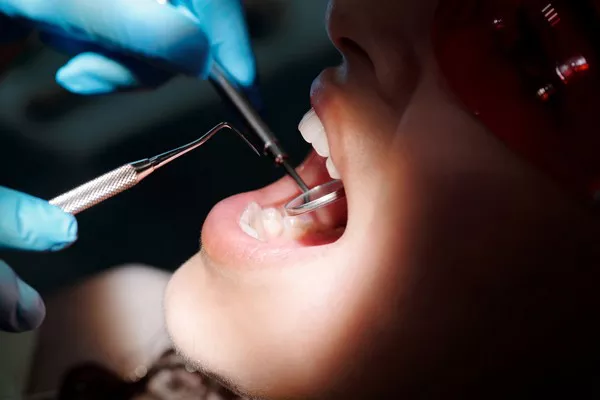Gingivitis is a prevalent form of gum disease characterized by inflammation and bleeding of the gums. It is primarily caused by the accumulation of plaque—a sticky film of bacteria—on the teeth and gums. If not removed through regular brushing and flossing, plaque can harden into tartar, which further irritates the gums. Although gingivitis is typically mild and reversible with proper oral hygiene, neglecting this condition can lead to more serious complications.
Link Between Gingivitis and Teeth Shifting
One of the lesser-known but significant consequences of untreated gingivitis is the potential for teeth shifting. Gingivitis can progress to periodontitis, a more severe form of gum disease that affects the structures supporting the teeth, including the soft tissue and bone. This progression can compromise the stability of the teeth, leading to noticeable shifting and even tooth loss in severe cases.
Symptoms of Gingivitis
Recognizing the early symptoms of gingivitis is crucial for timely intervention. Common signs include:
Red, swollen gums: Healthy gums are typically firm and pink. Inflammation caused by gingivitis can make the gums appear red and swollen.
Bleeding during brushing or flossing: One of the hallmark symptoms of gingivitis is bleeding gums, especially when performing oral hygiene routines.
Tenderness or discomfort: Gums affected by gingivitis may be tender to the touch and cause discomfort.
Persistent bad breath: Bad breath, or halitosis, can result from the bacterial buildup associated with gingivitis.
Receding gums: As gingivitis progresses, it can cause the gums to pull away from the teeth, creating pockets where more plaque and bacteria can accumulate.
Progression to Periodontitis
If left untreated, gingivitis can advance to periodontitis, a serious gum infection that damages the soft tissue and bone supporting the teeth. Periodontitis is marked by the formation of deep pockets between the teeth and gums, which fill with bacteria and pus. The body’s immune response to this infection can destroy the bone and connective tissue that hold the teeth in place. As a result, teeth can become loose, shift, or even fall out.
The process from gingivitis to periodontitis involves several stages:
Plaque and Tartar Buildup: Plaque that is not removed hardens into tartar, which can only be removed by a dental professional. The presence of tartar exacerbates inflammation and provides a breeding ground for more bacteria.
Gum Inflammation: The body’s immune response to the bacteria in plaque and tartar causes the gums to become inflamed. This inflammation is the body’s way of fighting infection but also results in the destruction of healthy tissue.
Pocket Formation: As the gums pull away from the teeth, pockets form. These pockets become filled with bacteria, which further infect and erode the gum tissue and bone.
Bone and Tissue Destruction: The ongoing immune response and bacterial infection lead to the breakdown of the bone and connective tissue that hold teeth in place.
Tooth Shifting and Loss: As the bone and tissues are destroyed, teeth lose their stable foundation, leading to shifting and, ultimately, tooth loss.
Prevention and Treatment
Preventing gingivitis is key to maintaining oral health and avoiding the complications of periodontitis and teeth shifting. Here are some effective strategies:
Good Oral Hygiene Practices: Brush your teeth at least twice a day with fluoride toothpaste. Floss daily to remove plaque and food particles between teeth and under the gumline.
Regular Dental Check-Ups: Visit your dentist regularly for professional cleanings and examinations. These visits help remove tartar and monitor the health of your gums.
Professional Cleanings and Scaling: Professional dental cleanings are essential for removing tartar that cannot be eliminated by brushing and flossing alone. Scaling and root planing are deep-cleaning procedures that can treat and manage gingivitis and periodontitis by cleaning below the gumline and smoothing the roots of the teeth to prevent bacteria buildup.
Healthy Diet: Maintain a balanced diet rich in vitamins and minerals to support gum health. Avoid sugary foods and drinks that can contribute to plaque buildup.
Avoid Tobacco: Smoking and using other forms of tobacco increase the risk of gum disease and hinder the healing process of the gums.
Use Antimicrobial Mouthwash: Mouthwashes containing antimicrobial agents can help reduce plaque and bacteria in the mouth.
When to See a Dentist
It is crucial to consult a dentist if you notice any signs of gingivitis, especially if you observe symptoms like persistent bleeding gums, significant gum inflammation, or shifting teeth. Early intervention can prevent the progression to periodontitis and preserve your oral health.
Here are some specific instances when you should see a dentist:
Persistent Bleeding Gums: If your gums bleed regularly during brushing or flossing, it’s a sign of inflammation that needs professional attention.
Swollen or Red Gums: Significant changes in the color and texture of your gums indicate possible gum disease.
Bad Breath or Bad Taste: Persistent bad breath or a bad taste in your mouth can be signs of gum infection.
Receding Gums: Noticeable gum recession or the formation of pockets around the teeth can signify advanced gum disease.
Loose or Shifting Teeth: Any movement of your teeth from their original position should be evaluated by a dentist immediately.
Conclusion
Understanding gingivitis and its potential to cause teeth shifting is essential for maintaining long-term oral health. While gingivitis is a common and often mild condition, neglecting it can lead to serious consequences, including periodontitis and tooth shifting. By recognizing the symptoms early, practicing good oral hygiene, and seeking regular dental care, you can prevent gingivitis from progressing and protect the stability and health of your teeth. Remember, your dentist is a crucial partner in keeping your gums healthy and your teeth in their proper place.
FAQs about Gingivitis and Teeth Movement
1. Does gingivitis make your teeth move?
Gingivitis itself does not directly cause teeth to move. However, if left untreated, gingivitis can progress to periodontitis, a more severe form of gum disease. Periodontitis can damage the supporting structures of your teeth, including the bone, which may result in teeth becoming loose and shifting.
2. Why are my teeth suddenly shifting?
Sudden teeth shifting can be caused by various factors, including:
Periodontal Disease: Advanced gum disease can lead to bone loss around the teeth, causing them to shift.
Tooth Loss: Losing a tooth can create space, causing adjacent teeth to move.
Bruxism: Grinding or clenching your teeth can put pressure on them, leading to movement.
Orthodontic Relapse: If you had braces and did not wear your retainer as instructed, your teeth might shift back to their original positions.
Aging: Over time, teeth can naturally shift due to changes in the jawbone.
3. Can gingivitis cause teeth to wiggle?
While gingivitis itself might not directly cause teeth to wiggle, it can lead to periodontitis if not properly treated. Periodontitis can result in the breakdown of the supporting bone and tissues around the teeth, which can cause them to become loose or wiggly. Therefore, maintaining good oral hygiene and seeking timely treatment for gingivitis is crucial to prevent this progression.
4. What disease causes teeth to move?
The primary disease that causes teeth to move is periodontitis, a severe form of gum disease. Periodontitis occurs when the gums and bone that support your teeth are infected and deteriorate. This can lead to tooth loss and movement. Other conditions that can cause teeth to move include:
Osteoporosis: A condition that weakens bones, potentially affecting the jawbone and causing teeth to shift.
Diabetes: Poorly controlled diabetes can increase the risk of gum disease, leading to tooth movement.
Pregnancy: Hormonal changes during pregnancy can affect the gums, making them more susceptible to disease and possible teeth shifting.
You Might Be Interested In





























